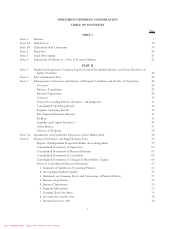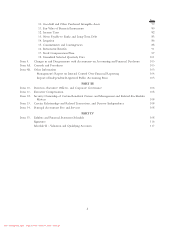Northrop Grumman 2009 Annual Report Download - page 18
Download and view the complete annual report
Please find page 18 of the 2009 Northrop Grumman annual report below. You can navigate through the pages in the report by either clicking on the pages listed below, or by using the keyword search tool below to find specific information within the annual report.BACKLOG
At December 31, 2009, total backlog was $69.2 billion compared with $76.4 billion at the end of 2008.
Approximately 37 percent of backlog at December 31, 2009, is expected to be converted into sales in 2010.
Total backlog includes both funded backlog (firm orders for which funding is contractually obligated by the
customer) and unfunded backlog (firm orders for which funding is not currently contractually obligated by the
customer). Unfunded backlog excludes unexercised contract options and unfunded indefinite delivery indefinite
quantity (IDIQ) orders. For multi-year services contracts with non-federal government customers having no
stated contract values, backlog includes only the amounts committed by the customer. For backlog by segment
see Backlog in Part II, Item 7.
RAW MATERIALS
The most significant raw material we require is steel, used primarily for shipbuilding. We have mitigated supply
risk by negotiating long-term agreements with a number of steel suppliers. In addition, we have mitigated price
risk related to steel purchases through certain contractual arrangements with the U.S. Government. While we
have generally been able to obtain key raw materials required in our production processes in a timely manner, a
significant delay in supply deliveries could have a material adverse effect on our consolidated financial position,
results of operations, or cash flows. See Risk Factors in Part I, Item 1A and Overview – Outlook in Part II,
Item 7.
GOVERNMENT REGULATION
Our businesses are affected by numerous laws and regulations relating to the award, administration and
performance of U.S. Government contracts. See Risk Factors in Part I, Item 1A.
The U.S. Government generally has the ability to terminate our contracts, in whole or in part, without prior
notice, for convenience or for default based on performance. If any of our government contracts were to be
terminated for convenience, we are normally protected by provisions covering reimbursement for costs incurred
and profit on those costs. Termination resulting from our default could require us to pay for re-procurement
costs in excess of the original contract price, net of the value of work accepted from the original contract. The
U.S. Government could also hold us liable for damages resulting from the default. In the event that
appropriations for one of our programs becomes unavailable, or is reduced or delayed, our contract or
subcontract under such program may be terminated or adjusted by the U.S. Government. See Risk Factors in
Part I, Item 1A.
Certain programs with the U.S. Government that are prohibited by the customer from being publicly discussed
in detail are referred to as “restricted” in this Form 10-K. The consolidated financial statements and financial
information in this Form 10-K reflect the operating results of restricted programs under accounting principles
generally accepted in the United States of America (GAAP). See Risk Factors in Part I, Item 1A.
RESEARCH AND DEVELOPMENT
Our research and development activities primarily include independent research and development (IR&D) efforts
related to government programs. IR&D expenses are included in general and administrative expenses and are
generally allocated to U.S. Government contracts. IR&D expenses totaled $610 million, $564 million, and
$522 million in 2009, 2008, and 2007, respectively. We charge expenses for research and development sponsored
by the customer directly to the related contracts.
EMPLOYEE RELATIONS
We maintain good relations with our 120,700 employees, of which approximately 20 percent are covered by
32 collective bargaining agreements. We re-negotiated 17 of our collective bargaining agreements in 2009. These
negotiations had no material adverse effect on our results of operations. For risks associated with collective
bargaining agreements, see Risk Factors in Part I, Item 1A.
-8-
NORTHROP GRUMMAN CORPORATION
eBP - v54508-i003_a.pdf - Page 12 of 124 - March 11, 2010 - 20:02:39
























